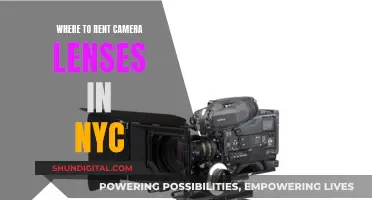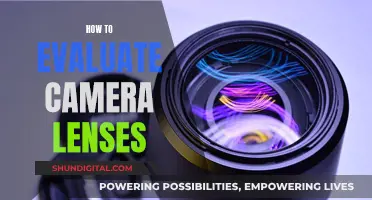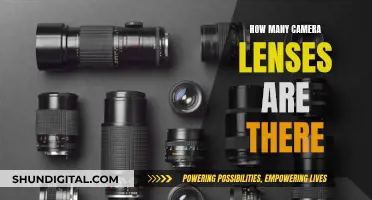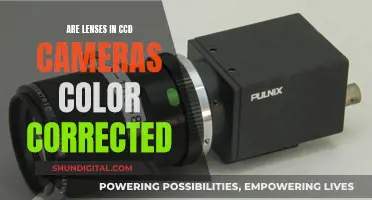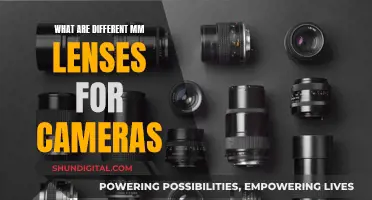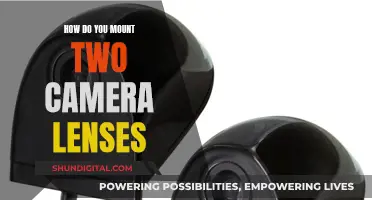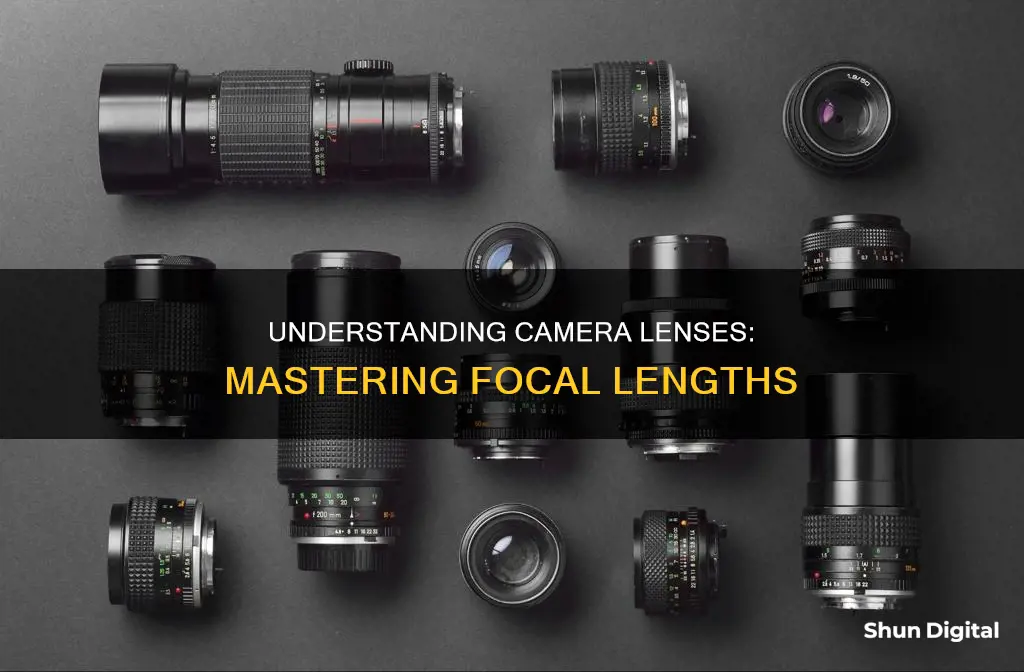
The numbers and letters on a camera lens can seem confusing at first, but they are actually easy to understand. The 'mm' number printed on a lens is a measurement in millimetres of the focal length. This is the basic description of a photographic lens and is the distance from the centre of the lens to the image focal point (or image sensor surface). The focal length tells you the angle of view (how much of the scene will be captured) and the magnification (how large individual elements will be). The longer the focal length, the narrower the angle of view and the higher the magnification. The shorter the focal length, the wider the angle of view and the lower the magnification.
| Characteristics | Values |
|---|---|
| Focal length | Calculated from the distance between the point where light rays converge to form a sharp image and the digital sensor or 35mm film at the focal plane in the camera. |
| Focal length representation | Usually in millimeters (mm). |
| Focal length and angle of view | The longer the focal length, the narrower the angle of view; the shorter the focal length, the wider the angle of view. |
| Focal length and magnification | The longer the focal length, the higher the magnification; the shorter the focal length, the lower the magnification. |
| Types of lenses | Prime (fixed focal length) and zoom (variable focal length). |
| Zoom lens | More versatile, ideal for photographing a variety of subjects, and reduces the need to change lenses. |
| Prime lens | More compact and lightweight than zoom lenses, have larger maximum apertures, and are better for low-light conditions and achieving a shallow depth of field. |
| Angle of view | The "angle of view" refers to how much of a scene will be captured in a photograph. |
| F-stop | Refers to the "speed" of the lens and the size of the aperture; a smaller f-stop number indicates a wider aperture, while a larger number indicates a narrower aperture. |
| Focal length and field of view | The smaller the focal length number, the wider the field of view; the larger the focal length number, the narrower the field of view. |
| Focal length and magnification | A shorter focal length (under 50mm) is good for capturing wide landscapes, while a longer focal length (over 50mm) is better for telephoto applications like wildlife photography or portraits. |
What You'll Learn
- Focal length: the distance from the lens centre to the image focal point, expressed in mm
- Angle of view: the width of the field included in the photo
- F-stop: how open the lens is, i.e. how much light it lets in
- Lens mount system: the type of mount the lens belongs to, usually denoted by a letter
- Lens diameter: the measurement around the outside circle of the lens

Focal length: the distance from the lens centre to the image focal point, expressed in mm
Focal length is a fundamental parameter of a lens that describes how strongly it focuses or diverges light. It is the distance, usually measured in millimetres (mm), from the lens centre (or nodal point) to the image focal point (or focal plane) when the lens is focused at infinity. In a film camera, the focal plane is the film; in a digital camera, it's the light-receptive surface of the sensor.
Focal length is not a measurement of the actual length of a lens but a calculation of an optical distance. It is the distance over which initially collimated (parallel) rays of light are brought to a focus. The longer the focal length, the more sharply the light rays are bent, and the longer the distance required to bring them to a focus.
The focal length of a lens determines its angle of view and field of view, which refer to how much of a scene will be captured by the camera. The longer the focal length, the narrower the angle of view and the smaller the field of view. Conversely, a shorter focal length results in a wider angle of view and a larger field of view.
In summary, focal length is the distance from the centre of the lens to the image focal point, expressed in millimetres. It is a key characteristic of a lens that determines its angle of view and field of view, with longer focal lengths resulting in narrower and smaller fields of view, and shorter focal lengths capturing wider and larger fields of view.
Lens Compatibility: Matching Lenses to Your Camera
You may want to see also

Angle of view: the width of the field included in the photo
The angle of view is the angle indicating the width of the field included in a photo. It is also described as the angular extent of a given scene that is imaged by a camera. The angle of view is measured in degrees.
The angle of view depends on the lens and the sensor. A camera with a smaller sensor than 35 mm film will have a narrower angle of view. The angle of view can also be affected by the focal length of the lens. The focal length is the distance from the centre of the lens to the image focal point, or image sensor surface. This is usually measured in millimetres (mm).
A lens with a short focal length is a wide-angle lens and will have a wider angle of view. A lens with a long focal length is a telephoto lens and will have a narrower angle of view. The shorter the focal length, the more of the scene that will be captured in the photo.
The angle of view can be calculated using the formula:
> {\displaystyle \alpha =2\arctan {\frac {d}{2f}}}
Where {\displaystyle d} represents the size of the film or sensor, and {\displaystyle f} represents the effective focal length.
Understanding Camera Lenses: Objective Focal Lengths Explained
You may want to see also

F-stop: how open the lens is, i.e. how much light it lets in
F-stop, also known as the f-number, is a crucial concept in photography that determines the aperture opening of your camera lens. Aperture refers to the hole in your lens that lets light pass through to the camera sensor. By adjusting the aperture, you control how much light enters the camera, which directly impacts the brightness of your photograph.
The f-stop is the ratio of the lens's focal length to the diameter of the aperture opening. It is expressed as a fraction, with the "f" representing the focal length. For example, an f-stop of f/2 means the aperture diameter is half the focal length. Each consecutive f-stop halves the opening of the previous one. So, if you change the f-stop from f/8 to f/16, the aperture diameter becomes one-sixteenth of the focal length, letting in much less light.
Understanding f-stops is essential for achieving the desired exposure in your photographs. A lower f-stop like f/1.4 or f/2 represents a larger aperture opening, allowing more light to enter the camera, resulting in a brighter image. Conversely, a higher f-stop like f/16 or f/22 indicates a smaller aperture, letting in less light and creating a darker image.
It's important to note that the f-stop values are counterintuitive for beginners because small physical apertures have high f-stop numbers, while large apertures have low f-stop numbers. This is because the f-stop represents a fraction; for example, f/16 is one-sixteenth, not sixteen.
Mastering the f-stop is crucial for photographers who want full control over their images. By adjusting the f-stop, you can not only control the amount of light entering the camera but also the depth of field, which refers to how much of the image appears sharp and in focus.
Recognizing Camera Lenses: A Beginner's Guide to Identification
You may want to see also

Lens mount system: the type of mount the lens belongs to, usually denoted by a letter
The lens mount system is an interface between a camera body and a lens. It is usually denoted by a letter or a combination of letters and numbers. The lens mount will determine which lenses are compatible with your camera.
Lens mounts can be categorised into three types: screw-threaded, bayonet-type, or breech-lock (friction lock). Modern still camera lens mounts are usually of the bayonet type, as this allows for precise alignment between the lens and body. Screw-threaded mounts are more fragile and cannot align the lens as reliably.
- EF-Mount (Electronic Focus) - Blackmagic URSA Mini, Blackmagic Production Camera, Canon 5D
- PL-Mount (Positive Lock) - Arri and RED digital cinematography cameras, Blackmagic URSA Mini, Blackmagic Production Camera
- F-Mount (Format Single-Lens Reflex) - RED EPIC MYSTERIUM-X, RED SCARLET MYSTERIUM-X
- A-Mount (Sony ‘Alpha’ Series) - Sony Alpha Series
- E-Mount (Sony Mirrorless) - Sony A7 iii
- Z-Mount (New Nikon Mirrorless) - Nikon's newer mirrorless cameras
- RF-Mount (New Canon EOS Mount) - Canon's new line of EOS lenses
- M43-Mount (Micro Four Thirds) - Blackmagic Pocket Cinema Camera, Panasonic Lumix DC-GH5, Olympus OM-D E-M1 Mark II
Understanding Camera Lenses: Measuring for Perfect Photos
You may want to see also

Lens diameter: the measurement around the outside circle of the lens
The circle with a line through it is the diameter symbol. So, when you see this symbol followed by a number, it refers to the diameter of your lens.
Not all lenses have the same diameter, and knowing the diameter of your lens is essential when purchasing lens filters and lens hoods. For example, if you have a 67mm diameter lens, you will need to buy lens filters and a lens hood that fit a 67mm diameter lens.
The diameter of the lens follows the diameter symbol.
Switching Camera Lenses: A Step-by-Step Guide for Beginners
You may want to see also
Frequently asked questions
The numbers on camera lenses refer to the focal length, which is measured in millimetres (mm). This is the basic description of a lens and tells you how much of the scene will be captured.
A wide-angle lens has a shorter focal length, usually under 50mm, and captures a broader view. A telephoto lens has a longer focal length, usually over 50mm, and captures a narrower, more magnified view.
Prime lenses have a fixed focal length and are more compact and lightweight. Zoom lenses have variable focal lengths and are more versatile, but tend to be more expensive.
The "mm" range on a zoom lens, such as 18-55mm, indicates the focal length range. For example, with an 18-55mm lens, you can use the widest angle (18mm) for a broader view or the most zoomed (55mm) for a narrower, more magnified view.


